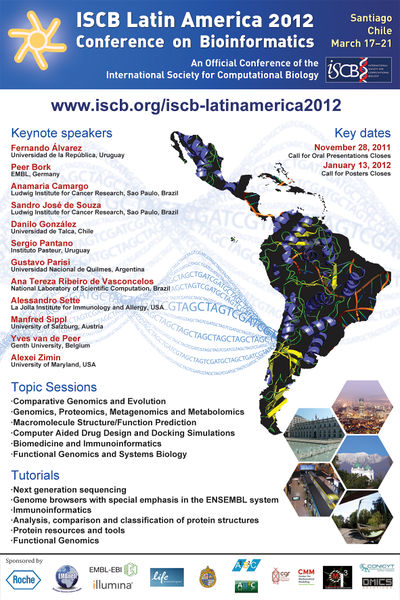Difference between revisions of "Conferences"
| Line 41: | Line 41: | ||
"Function prediction at different spatial scales", Peer Bork, EMBL, Heidelberg, Germany (www.bork.embl.de) | "Function prediction at different spatial scales", Peer Bork, EMBL, Heidelberg, Germany (www.bork.embl.de) | ||
| − | + | Drug target identification using side-effect similarity.Campillos M, Kuhn M, Gavin AC, Jensen LJ, Bork P,Science,2008 | |
''Targets for drugs have so far been predicted on the basis of molecular or cellular features, for example, by exploiting similarity in chemical structure or in activity across cell lines. We used phenotypic side-effect similarities to infer whether two drugs share a target. Applied to 746 marketed drugs, a network of 1018 side effect-driven drug-drug relations became apparent, 261 of which are formed by chemically dissimilar drugs from different therapeutic indications. We experimentally tested 20 of these unexpected drug-drug relations and validated 13 implied drug-target relations by in vitro binding assays, of which 11 reveal inhibition constants equal to less than 10 micromolar. Nine of these were tested and confirmed in cell assays, documenting the feasibility of using phenotypic information to infer molecular interactions and hinting at new uses of marketed drugs. | ''Targets for drugs have so far been predicted on the basis of molecular or cellular features, for example, by exploiting similarity in chemical structure or in activity across cell lines. We used phenotypic side-effect similarities to infer whether two drugs share a target. Applied to 746 marketed drugs, a network of 1018 side effect-driven drug-drug relations became apparent, 261 of which are formed by chemically dissimilar drugs from different therapeutic indications. We experimentally tested 20 of these unexpected drug-drug relations and validated 13 implied drug-target relations by in vitro binding assays, of which 11 reveal inhibition constants equal to less than 10 micromolar. Nine of these were tested and confirmed in cell assays, documenting the feasibility of using phenotypic information to infer molecular interactions and hinting at new uses of marketed drugs. | ||
Revision as of 16:53, 24 April 2012
This section has been created in order to keep track of the conferences attended by the CBG members.
International Society of Computational Biology (ISCB) - Latin America 2012 - Santiago, Chile - March 17-21
- General info
The International Society for Computational Biology (ISCB) has held the ISCB Latin America Conference on Bioinformatics in Santiago, Chile, in March 17-21, 2012. This meeting constituted the second regional ISCB Latin America meeting, with the first held in Montevideo, Uruguay, in March 2010.
Conferences are key to the development and exchange of new ideas in science. Over the years many thousands of participants have attended ISCB’s annual ISMB conferences. As the majority of those attendees do their research in North America and Europe, the ISCB Regional Conferences aim to break the barrier imposed by high cost travel. How? By bringing a high quality conference, including lectures delivered by world-renowned scientists, to the regions of Latin America, Africa and Asia.
Toward this aim, in 2009 ISCB began organizing a newer series of smaller, regionally-based meetings as part of its mission to advance the science through world-wide education and training activities. These regional meetings have included ISCB-Africa (Mali 2009, South Africa 2011), ISCB-Latin America (Uruguay 2010) and ISCB-Asia (Malaysia 2011).
ISCB also aims to provide more students the opportunity to discuss and participate in the latest developments in bioinformatics and computational biology by bringing these meetings closer to home. We hope the ISCB-Latin America 2012 has been the second of many conferences that will contribute to the growth of the field within this region and support scientific innovation across Latin America.
More than 250 people attended, primarily from countries in Latin America.
The first two days of the meeting (March 17-18) were dedicated to hands-on practical tutorials and workshops covering different topics of interest.
The main conference took place March 19th-21st and featured the following six topic sessions (Each session had two keynote speakers and six oral presentations. There were also two poster sessions):
Session I. Comparative Genomics and Evolution
Session II. Genomics, Proteomics, Metagenomics and Metabolomics
Session III. Macromolecule Structure/Function Prediction
Session IV. Computer Aided Drug Design and Docking Simulations
Session V. Biomedicine and Immunoinformatics
Session VI. Functional Genomics and Systems Biology
The programme book of the conference
Poster presented at the conference
- Selection of talks
"Function prediction at different spatial scales", Peer Bork, EMBL, Heidelberg, Germany (www.bork.embl.de)
Drug target identification using side-effect similarity.Campillos M, Kuhn M, Gavin AC, Jensen LJ, Bork P,Science,2008
Targets for drugs have so far been predicted on the basis of molecular or cellular features, for example, by exploiting similarity in chemical structure or in activity across cell lines. We used phenotypic side-effect similarities to infer whether two drugs share a target. Applied to 746 marketed drugs, a network of 1018 side effect-driven drug-drug relations became apparent, 261 of which are formed by chemically dissimilar drugs from different therapeutic indications. We experimentally tested 20 of these unexpected drug-drug relations and validated 13 implied drug-target relations by in vitro binding assays, of which 11 reveal inhibition constants equal to less than 10 micromolar. Nine of these were tested and confirmed in cell assays, documenting the feasibility of using phenotypic information to infer molecular interactions and hinting at new uses of marketed drugs. Microbiome from gut
"Amazing protein folds", Manfred Sippl, University of Salzburg, Austria
"Using genomics to improve response to neoadjuvant therapy in patients with rectal cancer", Anamaría Camargo, Ludwig Institute for Cancer Research, Brazil
"Using 'omics' data to study regulator-target interactions and organizational principles in networks", Yves van de peer, University of Ghent, Belgium
"On the evolution of PPI networks", Sandro Jsé de Souza, Ludwig Institute for Cancer Research, Brazil
- Bioinformatics Training and Education in Iberoamerica
